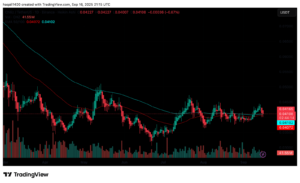Crypto traders with ‘emotionless approach’ to do well this cycle — Exec

Introduction
The cryptocurrency market is as volatile and dynamic as ever. In this cycle, we’re seeing the surge of memecoins grabbing headlines, Ethereum Layer 2 projects gaining traction, and Bitcoin pushing against long-term resistance zones. Amid the excitement, the buzz, and the emotional swings of retail participants, one fundamental aspect remains unchanged—discipline outperforms hype. In the pursuit of alpha, many traders fall prey to emotionally charged decisions that often contradict their long-term strategy. The coming months will undoubtedly be shaped by sudden pumps, sensational predictions, and macro shocks, but the investors who thrive will be the ones who adopt a data-driven, emotionless approach to trading.
Truly successful traders know that consistency doesn’t come from predicting every market movement correctly—it comes from executing a well-devised plan, regardless of emotional noise. Whether the market is deep in a bear phase or riding the wave of speculative mania, emotionless execution is the North Star for seasoned professionals in the space.
The Significance of Emotionless Trading
Emotional trading has been the downfall of countless investors. When price action intensifies, our instincts trigger reactions rooted in fear, greed, and hope. These primal emotions are intricately wired into human decision-making, but in the high-stakes world of crypto trading, acting on these impulses harms performance more than it helps.
Fear often manifests during drawdowns or sharp corrections. It drives otherwise rational investors to panic-sell, realizing losses that may have rebounded with patience. Greed has the opposite effect—encouraging irrational entries into already-overextended assets, often at cycle tops. Hope is the silent killer of performance, causing traders to hold onto underperforming tokens far longer than logic would dictate, with the misguided expectation of a reversal that never comes.
To truly succeed as a trader, emotional detachment is critical. Markets reward those who can interpret data, follow systems, and execute without hesitation. While it may be tempting to dive headfirst into a coin that’s up 300% in a week because it’s trending on social media, disciplined traders recognize patterns, assess risk, and act only when their setup confirms.
As one seasoned executive put it: “The money isn’t made in the trend, it’s made in the plan. Traders who stick to data-driven habits and detach from the dopamine cycles of wins and losses will outperform everyone chasing hype.” Patience and precision beat impulsiveness every time.
Strategies for Emotionless Trading
How can you remove emotion from your trading process? It starts with building robust strategies that govern your decision-making and reduce the influence of impulse. Below are proven techniques used by seasoned professionals to stay grounded in times of market turbulence:
- Define Clear Profit and Exit Levels: Every trade should start with an end in mind. Develop a disciplined approach by setting predefined take-profit targets and stop-loss points before you enter a position. Using limit and stop orders will automate your exits, removing the temptation to second-guess your plan once a trade is live. Execution transforms intention into real gains, and clearly defined levels remove emotional decision-making from critical moments.
- Stick to a Trading Plan: Successful traders don’t improvise mid-trade. Your strategy—whether based on macro sentiment, technical indicators, or on-chain analytics—must be outlined ahead of time and followed without deviation. The market may trick you into thinking this time is different, but in reality, abandoning your plan is the fastest route to avoidable losses.
- Use Position Sizing and Risk Management: Position sizing is your first line of defense against emotional volatility. Limiting exposure to a small percentage of your total portfolio keeps losses manageable and maintains your composure. Overleveraged, oversized trades amplify both profits and anxiety, leading to suboptimal exits. Sticking to a risk-to-reward ratio and never risking more than you’re comfortable losing creates longevity in your trading career.
- Leverage Tools, Not Gut: Emotional traders rely on feelings. Professional traders rely on systems. Use automated solutions such as trading bots, condition-based alerts, and order execution platforms. These tools help you adhere to your plan even in the most volatile conditions. When the market moves too fast for emotion-free human judgment, automation keeps you systematically profitable.
Case Studies of Successful Traders
Case studies offer real-world proof of discipline outperforming emotion. Consider the story of “Crypto Kay,” a pseudonymous trader who parlayed a $50,000 portfolio into $8.3 million over the course of the last bull cycle. His success wasn’t driven by catching every pump or shorting every correction—it was structured around a consistent system. He turned off mobile trading notifications, built trades with pre-set criteria, avoided communities prone to hype, and didn’t chase headlines. “Had I followed my emotions,” he later shared, “I’d never have reached the second comma.”
Another compelling example is Lucia Zhang, a digital asset manager who successfully guided her firm through the turbulence of the Ethereum Merge. While retail traders jumped in and out of positions based on influencer speculations and market hype, Lucia relied on sector-specific research, trend confirmations, and predefined entry zones. Her firm’s controlled allocations ahead of the Merge story yielded a sizable gain of 76% in a single quarter—while retail investors experienced paralyzing drawdowns due to ill-timed entries and emotional exits.
These examples validate a crucial point: overwhelming market volatility isn’t something to avoid—it’s something to be harnessed with a methodical approach. Traders who remove emotion from the equation are able to capitalize on inefficiencies, while others react impulsively and provide liquidity to the disciplined.
To better understand how long-term market cycles impact emotionless trading strategies, it’s important to study macro trends and recurring patterns. Our comprehensive analysis of Bitcoin’s bull and bear markets reveals just how predictable investor psychology can be over time—further reinforcing the need for a rules-based system.
How to Build Emotional Discipline Over Time
Emotionless trading is not a switch you simply flip—it’s a skill developed through repetition, journaling, and experience. Keeping a trade journal is one of the most underrated methods of building accountability and understanding your own emotional tendencies. After each trade, note not just the outcome, but also how you felt during execution and whether you followed your system.
Establish daily routines to ground your mindset. Many professional traders begin the day reviewing macro data, backtesting systems, and conducting pre-market analysis. When your mind is clear and your systems are planned out in advance, the chance of an impulsive trade drastically decreases.
Remember that emotional detachment doesn’t mean apathy. It means installing guardrails around your strategy, understanding the probability-based nature of trading, and accepting both wins and losses as part of the process.
Conclusion
In a market notorious for volatility, distraction, and misinformation, your best defense—and your greatest strength—is emotionless execution. While social media influencers chase virality, and retail speculators follow hype cycles with reckless abandon, the real winners use data, discipline, and planning to quietly position themselves for sustainable gains.
The next phase of this crypto cycle will reward those who take themselves seriously as traders. Success won’t come from being early on the next meme coin—it will come from consistency, solid risk management, and eliminating fear and greed from your trading decisions. The markets are rigged against the emotionally reactive and generously reward the strategically disciplined.
If you’re ready to advance beyond emotional trades and start building robust strategies for the coming cycle, dive deeper into market projections and historical trends. Our in-depth Bitcoin Price Prediction for 2024–2030 offers guidance rooted in macro analysis, on-chain metrics, and realistic risk models.
Bulls roar, bears maul, but neither controls your execution. Stick to your strategy—emotionless, data-driven, and consistent. That’s how lasting success in crypto is achieved.





